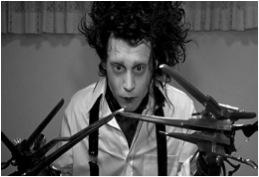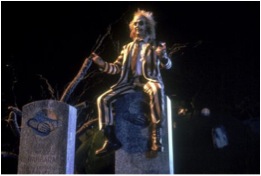“It is useful to consider a film as a hierarchy. At the highest level, a film is a sequence of scenes, each of which captures a specific situation or action. Each scene, in turn, is composed of one or more shots. A single shot is the interval during which the movie camera is rolling continuously. Most shots generally last a few seconds, although in certain cases they can go on much longer.”
(He, Cohen & Salesin, 1996)
In The Journal of Broadcasting, Robert K. Tiemens says, “The angle of a shot has a marked influence on the audience’s psychological reactin to the subject matter photographed.”
(Tiemens, 1970)
One technique that is perhaps more identified with Burton than anything else is that of stop-motion animation. Although Burton has only used this technique in a few of his films, the iconic “The Nightmare Before Christmas” has made this technique forever associated with Burton. Follow-up efforts like “Corpse Bride” were also very well-received. Stop-motion involves using physical sets and puppets and shooting each subsequent frame of the film as the puppets are moved through the motions you end up seeing on film.
He originally wanted to direct “The Nightmare Before Christmas” stop-motion movie himself but at the time of shooting, he was also pre-occupied with another movie that he was directing, Batman Returns. He produced and co-wrote the script for the movie and Henry Selick got on board to direct it. Tim Burton wrote the poem back in the 1980’s when he was still an animator for Disney. In 1990, he made a deal with Walt Disney Pictures to turn his poem into a full-length film.
(http://www.ehow.com/info_8651006_tim-burtons-camera-techniques.html)
The dutch angle or dutch tilt is a film technique that appears in many of Burton’s films. While certainly not unique to the director, he employs the technique much more frequently than more conventional filmmakers. The shot involves tilting the camera when shooting a frame in order to create a skewed sense of tension. In the resultant shot, the horizon of the shot will be on an angle rather than on a horizontal plane. He uses the technique in both his live-action and stop-motion camerawork.
(http://www.ehow.com/info_8651006_tim-burtons-camera-techniques.html)
Burton enjoys employing point-of-view shots quite often in his films. This technique is demonstrated most clearly in one of his breakout early successes, “Edward Scissorhands” starring Johnny Depp. This film has several shots where the camera is clearly seeing something from the point of view of a specific character, rather than serving as an outside eye looking in.
(http://www.ehow.com/info_8651006_tim-burtons-camera-techniques.htmlColor)
Color is a large part of Burton’s camera mastery. He shoots subjects in oversaturated and undersaturated color, often in order to use the color of the scene to help add to the Gothic mystery or surreal and dreamlike states that his stories frequently find themselves in. Although digital color grading assists in the process of achieving vibrant and specific coloring in his pictures, such as in “Charlie and the Chocolate Factory,” Burton is still known for using the camera to capture color unlike that which most other directors put on the screen.
(http://www.ehow.com/info_8651006_tim-burtons-camera-techniques.html)
There is a large variety of different shots that a cinematographer or director can incorporate into a film. For example, there is what’s called a rack focus, eye level shots, close ups, medium shots, wide shots, and ariel shots. Below, I will give examples of how each of these shots are used by Tim Burton in his film, “Alice in Wonderland”, and “Edward Scissorhands.”
1. Focus Shot/Rack Focus: This is a shot that focuses on one prop or person in the scene, while the scene goes out of focus. Using the scene in Alice in Wonderland as example, when Alice is kneeled down in front of the mouse hole and she noticed there is a drink on the table. The focus changed from her to the drink with the scene going out of focus.
2. Eye Level Shot. It is a shot that shows you the world through the character’s eyes.
Burton uses this shot when Alice is falling down the rabbit hole, and you see all of the items surrounding her by the point of Alice, herself.
3. Close up. Close up is a shot that shows you a closer look of a character or prop in the scene. For example, there is a close up of the Cheshire Cat’s head when it is appears from the thin air.
4. Medium Shot. This is a shot that shows you a character from the top of the head to right above the waist. For example, in Alice in Wonderland, there is a scene when the Mad Hatter is talking to Alice showing just from the head to the waist.
5. Wide Angel Shot. This shot is an establishing shot. An establishing shot can be a very wide shot, one that frequently shows the setting of where the upcoming shots take place. This shot can be found in the scene of Alice in Wonderland, where at the moment that Alice walked out from the mouse hole and walked down the staircase. In Edward Scissorhands, when Peg Boggs visits the mansion for the first time to sell Avon products, the camera changes its perception to view Peg’s view of the castle in a long shot emphasizing the feeling of unreality and illusion. As she reaches the castle, long and wide angled shots are used to convey the size of the character and also to show Peg’s vulnerability in the new but strange environment.
6. Ariel Shot. It is usually done with a crane or with a camera attached to a special helicopter to view large landscape. For instance, they used Ariel shot when Alice climbed out from the rabbit hole and walked away back to the party.
Work Cited:
He, L., Cohen, M. F., & Salesin, D. H. (1996). The virtual cinematographer: A paradigm for automatic real-time camera control and directing.
Tiemens, R. K. (1970). Some relationships of camera angle to communicator credibility. 14(4), 483-490.


